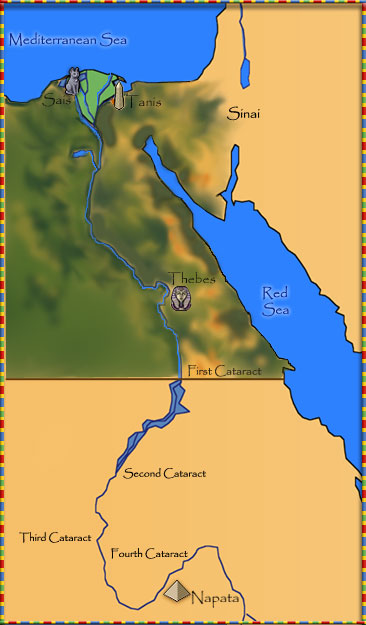|
Introduction
This assignment is a simulation that places you in
the position of a community leader over several years
in the aftermath of the collapse of Egypt's New Kingdom
Empire around 1070 BC. This period was a time of political
and social upheaval, with power shifting from a centralized
government under a single Pharaoh, to parallel dynasties
ruling at the same time, each with it’s own Pharaoh
(Dynasties 22, 23, 24, and 25). Nubians played an important
role in Egyptian politics during this time, eventually
ruling as Pharaohs over all of Egypt. Egypt was finally
conquered by the Assyrian king Assurbanipal in 663 BC.
The Cities:
 Tanis Tanis
Tanis was the home of the Pharaohs of the 21 st and
22 nd dynasties. Powerful rulers like Sheshonk I led
military campaigns into Syro-Palestine. Sheshonk laid
siege to Jerusalem and carried the riches of Solomon's
Temple back to the capital (lost Ark anyone?). In 1939,
French archaeologists Pierre Montet discovered the intact
burials of several of these Pharaohs dripping in gold
and silver. The huge city held a temple to Amun, and
it’s strategic location in the Nile Delta made
it a key center for trade to the Middle East and through
the Mediterranean.
 Sais Sais
The warrior goddess Neith was the patron deity of
Sais, another important Delta city. A key religious
and political center from the beginnings of Egyptian
history, Sais moved into prominence during our period
when its ruler Tefnakht founded the 24 th dynasty and
vied with the Nubians for the control of Egypt. Eventually,
the Saites came out on top with the help of the Assyrians
as the 26 th dynasty.
 Thebes Thebes
Thebes was simply known as "the City"
and remained Egypt's religious center even after
the end of the New Kingdom. It's leaders wielded
great influence and sometimes took on royal airs even
though they ultimately acknowledged the authority of
the Pharaohs ruling from the Delta. The great temple
of Amun was the largest religious complex in Egypt and
arguably in the world. It's wealth gave the rulers
of Thebes great power. They eventually allied with the
Nubians and helped usher in the 25th dynasty.
 Nubia Nubia
Nubia went from subjugated territory to the saviors
of Egypt during this period. Heading north from Napata
and the sacred mountain at Gebel Barkal, Nubian Pharaoh
Piye felt that he was the guy to restore order and unite
Egypt against the Assyrian threat. Rulers like Shabako
fought successfully against the Assyrians, but ultimately
to no avail. Nubia had access to gold and the wealth
of sub-Saharan Africa, including ivory, ebony and incense.
At the fourth cataract of the Nile, Nubian Pharaohs
revived the practice of pyramid building and expanded
the temples to Amun at Gebel Barkal, creating a southern
rival to Thebes in the north.
Your goal is to ensure the gradual expansion of your
community's influence over other communities up and
down the Nile, without getting conquered or deposed.
You have a range of variables that you must track in
order to manage effectively. These include population
growth and decline, land area under cultivation, temple
construction, the size of your civil service, military
size, and defensive walls to mention some of the most
important. Note that this is a turn-based simulation,
so you will be running the simulation against other
students in your study group, so competition and cooperation
will come into play.
|

There are three versions of the simulation, one for
MacOS X, MacOS 9 and Windows. Please download the version
appropriate for the computer you are currently running. MacOS
X | MacOS
9 |Windows
|
